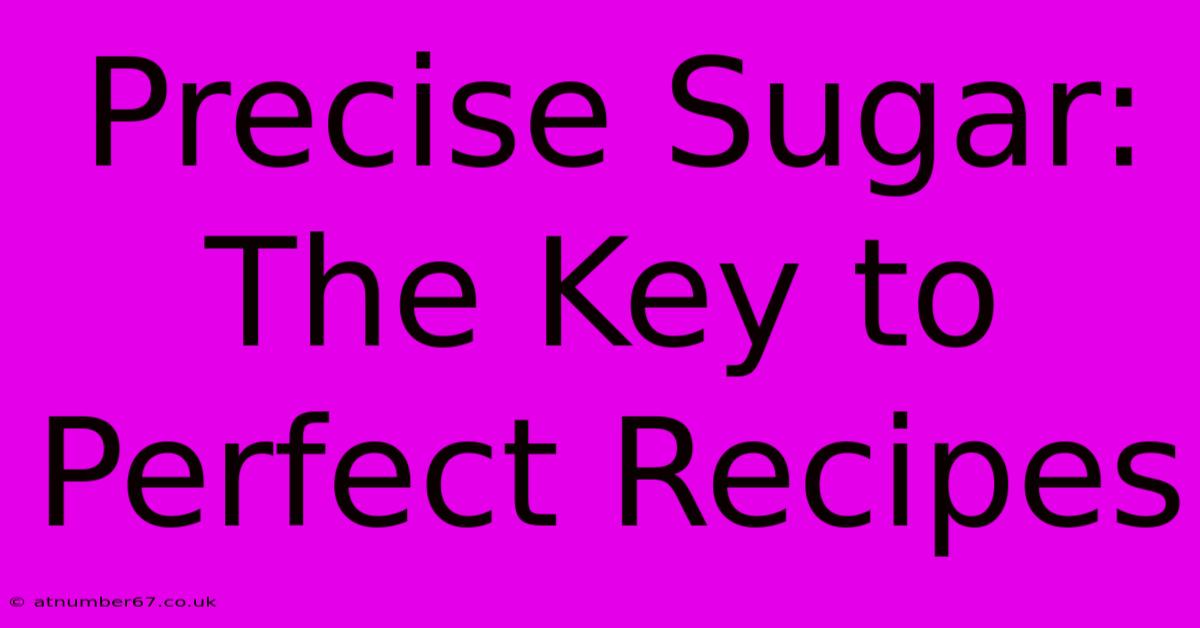Precise Sugar: The Key To Perfect Recipes

Table of Contents
Precise Sugar: The Key to Perfect Recipes
Sugar. It's more than just sweetness; it's a crucial ingredient impacting texture, browning, and overall success in countless recipes. While many home cooks might toss in a pinch here and there, achieving truly perfect results demands precise sugar measurement. This article delves into why precise sugar measurement is paramount and provides tips and tricks to ensure your baking and cooking always hit the mark.
The Science Behind Sugar's Precision
Sugar's role extends far beyond simply adding sweetness. Different types of sugar – granulated, powdered, brown, etc. – possess varying properties influencing the final product. Let's break down some key aspects:
Granulated Sugar: The Baking Workhorse
Granulated sugar is the foundation of many recipes. Its fine crystals dissolve relatively quickly, contributing to even browning and a crisp texture in cookies and cakes. Inaccurate measurement here directly impacts rise, texture, and overall sweetness. Even a tablespoon off can lead to a dense cake or overly chewy cookies.
Powdered Sugar (Confectioners' Sugar): Light and Airy
Powdered sugar, with its incredibly fine consistency, is ideal for creating light and airy frostings, glazes, and meringues. Its finely milled structure incorporates air, leading to a delicate texture. Precise measurement is crucial here to maintain the desired consistency. Too much will lead to a heavy, clumpy frosting, while too little will result in a runny mess.
Brown Sugar: Moisture and Flavor
Brown sugar, containing molasses, adds moisture and a distinct caramel-like flavor. This moisture content is essential for chewy cookies and moist cakes. However, the moisture content can vary between brands and even batches, requiring careful attention to measurement. Using a scale ensures consistency, avoiding overly dry or soggy results.
Mastering Precise Sugar Measurement: Techniques and Tools
Achieving precision requires the right tools and techniques:
1. The Kitchen Scale: Your Best Friend
A digital kitchen scale is the most accurate method for measuring sugar. It eliminates the inconsistencies associated with volume measurements (cups, tablespoons). Weighing your sugar guarantees consistency across batches and different types of sugar.
2. The Spooning Method (for Volume Measurements):
If you don't have a scale, use the "spoon and level" method. Do not pack the sugar into the measuring cup; gently spoon it in until it's level with the top. This minimizes air pockets and ensures more consistent results than scooping directly from the bag.
3. Understanding Sugar's Compaction:
Brown sugar, in particular, compacts easily. If using volume measurements, fluff the brown sugar with a fork before scooping to avoid under-measuring.
4. Consistent Measuring Tools:
Ensure your measuring cups and spoons are in good condition and accurately calibrated. Old, worn-out measuring tools can lead to inaccuracies.
Beyond Measurement: Other Factors Affecting Sugar's Performance
While precise measurement is critical, other factors influence sugar's behavior in recipes:
- Type of sugar: As discussed above, different sugars have different properties.
- Temperature: Sugar dissolves more easily in warm liquids.
- Mixing techniques: Proper mixing incorporates sugar evenly, preventing clumping.
Conclusion: The Sweet Reward of Precision
Precise sugar measurement might seem like a small detail, but it's the key to unlocking consistently perfect recipes. By employing the techniques and tools outlined above, you'll elevate your baking and cooking to a new level of precision and deliciousness. Embrace the science of sugar, and savor the sweet reward of perfectly executed recipes every time!
FAQs
-
Q: Can I substitute different types of sugar in recipes? A: Generally, you can substitute, but it might affect the final product's texture and flavor. Always consult a reliable recipe source for guidance.
-
Q: Why is my cake dense even though I followed the recipe? A: It could be due to inaccurate sugar measurement, improper mixing, or incorrect baking temperature.
-
Q: How do I store sugar to maintain its quality? A: Store sugar in an airtight container in a cool, dry place. Brown sugar can be stored with a slice of apple or a damp paper towel to maintain its moisture content.
This article is optimized for search engines by incorporating relevant keywords throughout the text naturally and using appropriate headings and subheadings. It also addresses common questions related to sugar measurement and baking.

Thank you for visiting our website wich cover about Precise Sugar: The Key To Perfect Recipes. We hope the information provided has been useful to you. Feel free to contact us if you have any questions or need further assistance. See you next time and dont miss to bookmark.
Featured Posts
-
Natasha Jonas Net Worth And Future Plans
Apr 12, 2025
-
Kareena Kapoors Daughters Unseen Photos
Apr 12, 2025
-
Burna Boys Age A Journey Through Time
Apr 12, 2025
-
Decoding Rokbloks Financial Success
Apr 12, 2025
-
Uzak Sehir Finale The Truth Revealed On You Tube
Apr 12, 2025
